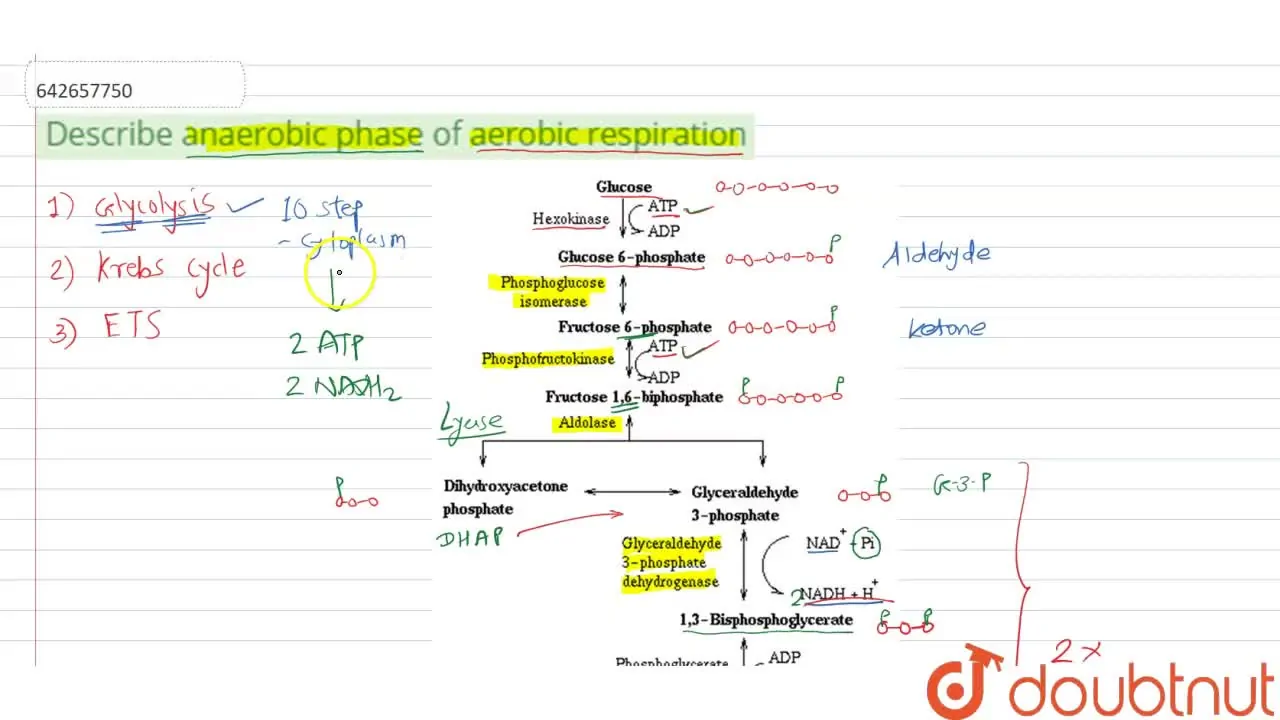Describe anaerobic phase of aerobic respirationSolution in Gujrati
Definition : Glycolysis means the phase till formation of two molecules of pyruvic acid from one molecule of glucose takes place.
Origin : The term glycolysis has originated form the Greek words glucose form sugar and lysis for splitting .
The scheme of glycolysis was given by Gustav Embden, Otto Meyercdof and J. Parnas and is often referred to as the EMP pathway.
In anaerobic organisms, only glycolysis occurs. Glycolysis occurs in the cytoplasm of the cell and in this process undergoes partial oxidation to form two molecules of pyruvic acid .
In plants, this glucose is derived from sucrose .
which is the end product of photosynthesis or from storage carbohydrates. Both these monosaccharides readily enter the glycolytic pathway.
Glucose and fructose are phosphorylated to give rise to Glucose-6- phosphate by the activity of the enzyme hexokinase.
Glucose + ATP Glucose-6-Phosphate
This phosphorylated form of glucose then isomerises to produce fructose-6- phosphate.
Glucose-6- Phosphate Fructose-6- Phosphate
Subsequent steps of metabolism of glucose and fructose are same.
In glycolysis, a chain of ten reactions, under the control of different enzymes, takes place to produce pyruvate from glucose.
Now fructose-6- phosphate is converted into fructose-1, 6 -biphosphate in presence of ATP.
ATP is utilised at two steps. First in the conversion of glucose into glucose 6-phosphate an in second step the conversion of fructose 6-phosphate to fructose 1, e-biphosphate.
Now the fructose 1,6-biphosphate is split into dihydroxyacetone phosphate and 3-phosphoglyceraldehyde (PGAL).
Fructose 1, 6-Biphosphate DHAP(3G) + PGAL (3G)
There is one step where NADH + is formed from , this is when 3-phosphoglyceraldehyde is converted to 1,3-biphosphoglycerate (BPGA).
3-phosphoglyceraldehyde 1,3-biphosphoglycerate + NADH
Two redox-equivalents are removed (in the form of hydrogen atoms) from PGAL, and transferred to a molecule of
PGAL is oxidised and with inorganic phosphate to get converted into BPGA.
The conversion of BPGA to 3-phosphoglyceric acid (PGA) ,is also an energy yielding process. This energy is trapped by the formation of ATP
Another ATP is synthesised during the conversion of PEP to pyruvic acid .
(Formation of ATP = 4ATP mode)
Pyruvic acid is then the key product of glycolysis. What is he metabolic fate of pyruvate ? depends on the cellular need.
There are three major ways in which different cells handle pyruvic acid produced by glycolysis
(1) Lactic acid fermentation.
(2) Alcoholic fermentation.
(3) Aerobic respiration.
fermentation takes place under anaerobic conditions in many prokaryotes and unicellular eukaryotes.
For the complete oxidation of glucose to , however, organisms adopt Kreb, cycle which is also called as aerobic respiration. This requires supply.

Related Playlists
- BOOK - KUMAR PRAKASHANCHAPTER - RESPIRATION IN PLANTSEXERCISE - Section - B (Difference /Scientific Reasons )7videos
RESPIRATION IN PLANTS
- BOOK - KUMAR PRAKASHANCHAPTER - RESPIRATION IN PLANTSEXERCISE - Section - C (Location-Function /Full Name / Formulas)26videos
RESPIRATION IN PLANTS
- BOOK - KUMAR PRAKASHANCHAPTER - PLANT KINGDOMEXERCISE - OBJECTIVE SECTION (FILL IN THE BLANKS)9videos
PLANT KINGDOM
- BOOK - KUMAR PRAKASHANCHAPTER - SAMPLE QUESTION PAPER FOR ANNUAL EXAMEXERCISE - SECTION - D2videos
SAMPLE QUESTION PAPER FOR ANNUAL EXAM
Similar Questions
Aerobic respiration and Anaerobic respiration
02:01View SolutionWhat are called stomata ?
03:28View SolutionAsexual reproduction is by .......... produced in zoosporangia in chlorophyceae.
03:08View SolutionExplain Hatch-Slack pathway.
07:31View SolutionThe common phase between aerobic and anaerobic respiration is called
View SolutionCommon phase between aerobic and anaerobic modes of respiration is
02:56View SolutionDescribe the process of respiration in Amoeba. State whether it is anaerobic respiration or aerobic respiration.
01:23View SolutionAnaerobic and aerobic respiration release
View SolutionAerobic and anaerobic respiration
03:43View SolutionThe common phase between aerobic and anaerobic respiration is called
View SolutionName the phase which is common for both aerobic and anaerobic respiration ?
03:53View SolutionThe phase common to aerobic and anaerobic respiration is
02:18View SolutionDescribe the common steps between aerobic and anaerobic respiration .
02:45View Solution(i) Describe aerobic respiration. (ii) Describe the process of anaerobic respiration.
03:13View SolutionAerobic respiration and Anaerobic respiration
View Solution


